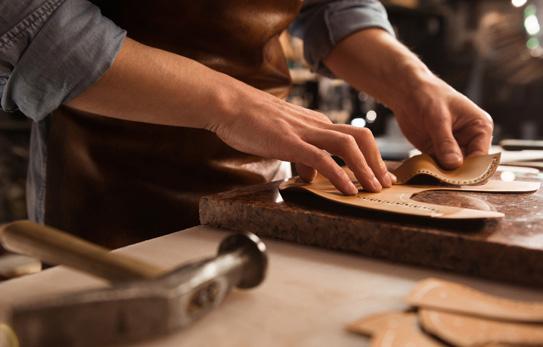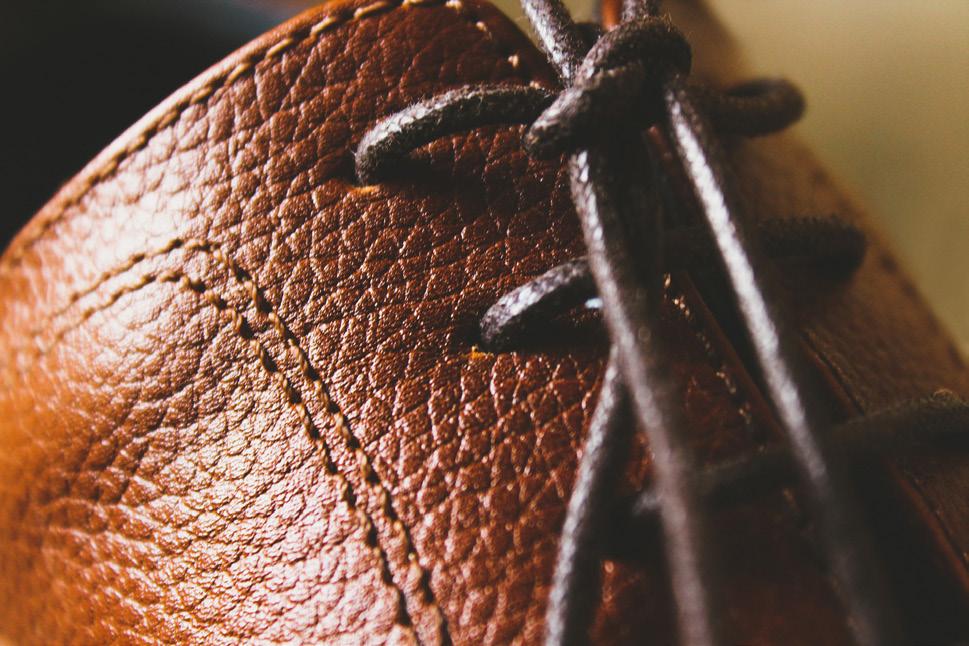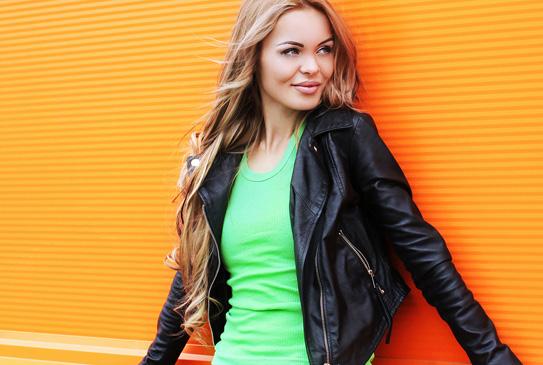
9 minute read
Leather, naturally
Leather is one of man’s earliest and most useful discoveries. Our ancestors used leather to protect themselves from the elements. Primitive man hunted wild animals for food, then made clothing, footwear and crude tents from the hides. Like then, hides used today are a by-product. Animals are raised for the meat, dairy and wool industries, not for their hides. Roughly half of all leather produced today is used to make shoes, and about 25% for clothing. Upholstery demands only around 15% of the total product.
Thanks to a unique arrangement of complex natural fibres that can be combined with the chemical and physical processes that leather workers have perfected over the course of several thousand years, leather stands as one of mankind’s greatest substances.
Leather Naturally is an industry members association that focuses on education and the promotion of leather. At all times promoting the use of globally-manufactured sustainable leather they seek to inspire and inform designers,
creators, and consumers about its beauty, quality and versatility as well as ensuring the highest standards of traceability and accountability.
PROPERTIES OF LEATHER Leather can be made to absorb water, resist water or be completely waterproof. Most leathers manufactured for the shoe, bag, upholstery and leather goods industries offer a degree of water resistance that enables the leather to get wet yet, after drying, retain the properties of elasticity and shape. Many leathers for leather goods are treated to avoid marks from water spotting in light rain.
Waterproofing can be made for specific applications, particularly for outdoor shoes and boots that allow for walking several hours in the rain without getting wet feet. Most waterproof leathers are made from cattle hides.
Cow leather can have a great variation of thicknesses because they can be split in layers. When split thin, leathers can be used for garment, gloves and leather goods. Medium thickness
leathers, on the other hand, are more widely used for upholstery, automotive parts, shoes, bags and leather goods, whereas thick leathers are used for footwear soles and crafts.

The softness of a leather is usually associated with its thickness. The thinner the leather, the softer it will be. But there are other variables that make leather softer, particularly the type of tannage: generally speaking, chrome tanned will be softer; aldehyde type tanning less soft and vegetable tanned leather firmer.
BREATHABILITY The amount of fatty materials added also influences the softness; the higher the amount of fatty material added to the leather, the greater the softness. Process variations allow us to get a wide range of softness, from a leather glove to a footwear sole from the same raw material.
This is one of leather’s unique properties, allowing the leather to absorb the moisture and with time release it into the environment. For shoes, this property creates outstanding comfort that is not replicated by any other material. Perspiration is drawn from the foot into the leather and then evaporates from the outer surface of the shoe. Leather can hold large quantities of moisture without feeling damp, so the foot stays dry and comfortable without the chill of fast evaporation or puddling of cooling perspiration. So, your feet don’t sweat in natural leather shoes and boots the way they tend to do when wearing synthetic and rubber footwear.
Often called ‘breathability’, this characteristic allows moisture and air to permeate through the leather. This property is particularly important for shoes’ comfort; as the foot sweats it can produce large amounts of moisture that move through the leather to the outside, keeping the inside of the shoe drier and more comfortable, with a lower moisture level. Waterproof leathers that are engineered to maintain breathability while providing protection from wet conditions will provide an outstanding combined performance.
There are many variations to the colour, texture, feel, smell, surface resistance and handle of leather that makes this product extremely unique and valuable. Leathers can be as natural as observed in pure vegetable leather or as refined with outstanding performance as an automotive seat. Leather is fashionable in all colours while maintaining outstanding technical performance.
One of the main reasons why leather is comfortable on the human skin is because of its strong thermal insulation capabilities. Heat insulation is a measure of the rate at which heat passes through a material. And because leather contains a large volume of air (which is a poor conductor of heat), the heat travels incredibly slowly through the material.

MALLEABILITY Another factor that makes leather such a favourable material is because of its ability to be moulded into a new shape. It can be made to either stiffen or can be made to be flexible and will retain its new shape as required. This is very important in footwear, since both feet are rarely exactly the same size and shape. With a little wear they soon adapt to fit perfectly.
A SELF REGULATING INDUSTRY One of the key roles of Leather Naturally is to educate people about the industry, inform and consult its members regarding best practises within the industry and to ensure that the industry is based on facts and figures.

While the leather industry is certainly not without its faults; it does play an important role in a circular economy which enables other industries to achieve their results of sustainability. The first step of the leather cycle, which is where companies like A + B HIDES comes into it, is to collect hides from the bovine meat and dairy industries. These hides are then collected, sorted and prepared for the remainder of the journey from hide to product.
Further to this, the industry is working very hard to be as accountable as possible with today’s leather being able to be traced back to the farm. This has allowed the industry to blacklist farms that mistreat the animals staying there. Technology is always being developed to further enhance the analytical evidence on hand to ensure that the industry is as efficient and sustainable as possible.
BASING A TRADE ON FACTS The facts of the industry are readily available but despite this Leather Naturally finds themselves often correcting the media when it comes to the leather industry. While this is certainly not their primary function, it is something that they do not allow to slip by unchecked.
Some businesses will set themselves up as “opponents” to leather, pushing their products as leather alternatives that are supposedly better. However, and this is an increasing issue, they don’t actually look at the facts but only run with the bias figures. Instead of looking at what the leather industry as a whole is doing to reduce the usage of chemicals, reduce their carbon footprint and only work with farms that treat their animals well, these businesses will showcase the very farms that the leather industry is blacklisting.
Whether these inaccuracies are down to a lack of comprehensive research or just down to poor writing, Leather Naturally always endeavours to make sure that they are corrected. This is after all part and parcel of changing people’s opinions of an industry.
And this is not unique to this sector either. Every sector of any size has as many opponents as it has advocates, but when inaccuracies are published or made public, the businesses within the sector need their association representatives to stand up and make sure that accuracies and facts are valued.
Part of the dilemma faced by these businesses is that leather is already a very sustainable product, as a material it outlasts the alternatives and thus means less need for replacing and it is completely biodegradable. It uses a by-product of other industries that would otherwise go to waste and frankly it is very beautiful.
LEATHER PRODUCTS Properly made and sourced leather is a truly sustainable material. Hides and skins are mostly a by-product that is dependent on the meat and dairy industry. Transformation into leather is the best use for those hides. The leather industry is creating a product that is both natural and long lasting - leather is unique in its ability to combine beauty, comfort and practicality.
Given the extensive range of raw materials with different properties, and the many processes developed over time leather making is highly versatile and leather manufacturers can produce qualities with widely varied properties and looks.
THE CIRCULAR ECONOMY OF LEATHER Modern leather manufacturing recycles over 270 million cow hides each year. These are a by-product of the food industry and without the ability of the leather industry to transform them into leather, over 7 million tonnes would go to landfill with huge environmental and biological impact. Leather makes a sustainable contribution to a society that needs to consume less, reuse more and a recycle everything.
REPAIRABLE The journey towards sustainability starts with products that can be repaired for longevity of use. Leather needs very little in the way of life-time
maintenance and it easy to do at home, it does not draw heavily on resources for laundering and drying for example and we increasingly see the revival of artisan skills/offering repair services for treasured leather goods.
RECYCLABLE Leather trimmings from the manufacturing process can be repurposed as stuffing, (into boxing punch bags for example) or combined with other materials to make composite products such as leatherboard, which is used for insoles and heel inserts in footwear.
Leather at end of life can be ground down to use in this way too. At the very end of its life leather will biodegrade, depending on type in between 10 & 50 years. We see leather trims being creatively incorporated into wall coverings, plus more and more companies are recycling the leather component from footwear and leathergoods into something new. Read the Peterson & Stoop article.
VERSATILE The skills of the leather makers take the same basic raw material and turn it into a many different ‘fabrics’ with different qualities and benefits. Leather can be engineered to be durable enough for furniture yet soft enough for comfort footwear. It will make the finest dress gloves or protective, abrasion resistant motorcycling gloves. Leather


makes the supplest of jackets or the firmest of walking boots.
Leather has a ‘breathability’ that more easily allows body temperature to be regulated, it will naturally absorb and hold moisture away from the skin until it can evaporate to the outside.
It will also mould to the wearer - whether it’s a glove, a shoe, leather jacket or wallet that’s been carried in a back pocket for years, leather conforms to its wearer for a very individual comfort and fit.
BEAUTIFUL Leather has a natural beauty that, unlike many materials, improves with age. Although every hide or skin is different, leather manufacturers work to bring out its best qualities, whether that’s a completely aniline or ‘naked’ appearance to one that is expertly finished to combine durability and easy care.
https://leathernaturally.org










